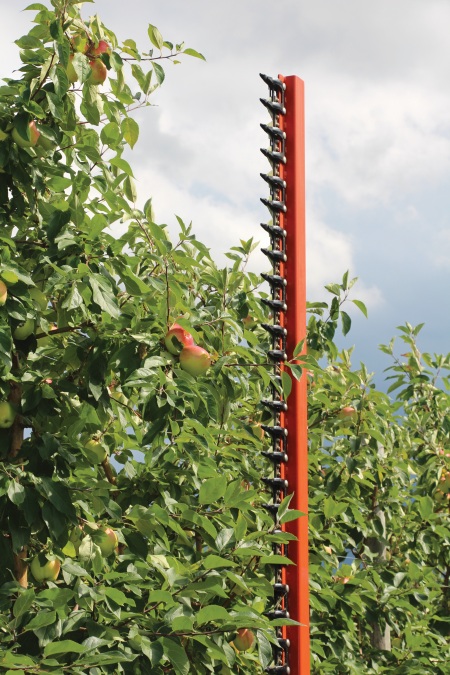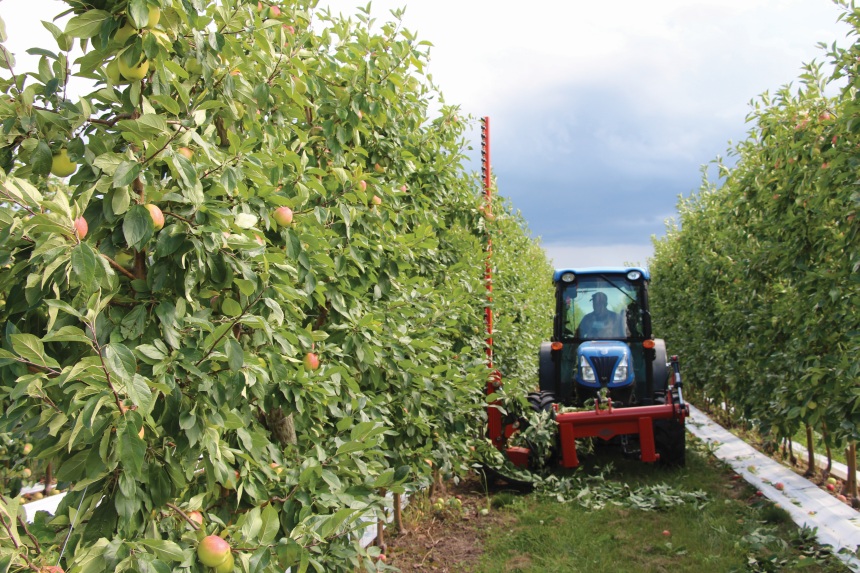Masters Of Maximizing Profit At Lamont Fruit Farms

Jose Iniguez, Rod Farrow, and Jason Woodworth, co-owners of Lamont Fruit Farms in Waterport, NY, have maximized the art of profit per acre. (Photo credit: Christina Herrick)
Whatever you do, don’t go to Lamont Fruit Farms in Waterport, NY, and talk about saving money to be more successful.
As co-owner Rod Farrow says, saving money should not be the ultimate goal of the orchard operation. Investing money to get the best possible return is.
“He’s not a cost minimizer, he’s a profit maximizer,” explains Mario Miranda Sazo, fruit Extension specialist for Cornell Cooperative Extension, Lake Ontario Fruit Program.
In essence, that’s exactly what makes Farrow and co-owners Jason Woodworth and Jose Iniguez so respected in the industry: their horticultural practices and their business acumen.
Farrow, Iniguez, and Woodworth grow mainly 2,000 trees to the acre in a super spindle system, with 29 different varieties such as SweeTango, Honeycrisp, Koru, Pazazz, Pink Lady, Empire, McIntosh, Red Delicious, and Zestar! What they accomplish on 480 acres is something other growers take note of.
“It is better to work on dollars per acre than bins per acre. You shouldn’t just look at the production costs — you should look at it as how much you invest in your orchard versus how much you get in return,” Farrow says. “We have consistently had the highest ‘dollar per acre costs’ but the lowest ‘dollar cost per dollar of income’ in the New York Fruit Farm Business Summary.”
Although it sounds counter-intuitive to have the highest total costs per acre, precisely directing the extra dollars spent toward increasing revenue through maximum yield of target sizes and percentage Extra Fancy gives him a lower cost per dollar of income.
“There are big gains to be had by doing things right,” he says.

Rod Farrow says growers should be careful when adopting mechanical hedging because the numerous heading cuts are not necessarily beneficial to every system. “We can dormant and summer hedge in our fruiting wall because the type of cuts made helps to stiffen the weak fruiting laterals that make up our structure and helps give us more uniformity,” he saus. (Photo credit: Christina Herrick)
Leading The Automation Charge
Along with making the leap to new varieties such as Zestar!, SweeTango, and Koru, Lamont Fruit Farms has moved into more automation. The team uses a Bin Bandit hauler with auto-steer, and a Bandit Xpress platform, both from Automated Ag, for dormant pruning, installing trellising and clips, hand thinning, summer pruning and harvest.
“We’ve eliminated the ladder in super spindle,” Iniguez says.
Crews enjoy night picking on the Bandit Xpress platform, which is equipped with LED lights, that reflect the color of the apples better.
Along with the automation, the farm has moved to mechanically hedging its super spindle blocks to create a fruiting wall with a LaGasse Works hedger. For more on this, see “Reducing Costs Through Mechanization.”
“Our goal is uniformity of wood. Once you get the trees close enough together to not need branches, your whole (growing) philosophy changes,” Farrow says. “Uniform wood type gives us uniform fruit.”
He acknowledges growers are more likely to make the jump to mechanical dormant pruning primarily to save money, but beware: In the wrong system “you may not be seeing the potential loss.”
Farrow, Iniguez, and Woodworth all recognize how much easier it is to train staff to hand thin with a consistent canopy.
“You should be (mechanically) hedging only if it makes your trees and systems physiologically better,” Farrow says. “The narrow canopy makes many tasks easier, especially hand thinning. Our goal is “95% Extra Fancy and 95% within our 3 target sizes.”

The team at Lamont Fruit Farms takes a progressive approach to staffing. “Give people the opportunity to excel,” Jose Iniguez says. “If our employees want it, we give them the chance.” (Photo credit: Christina Herrick)
Progressive Staffing Approach
Along with progressive growing practices, Farrow, Woodworth, and Iniguez also take a distinctive approach to staffing, which pays them big dividends in the long run.
“It’s a process of finding good people,” Farrow says. “We always challenge them to do more, to take on more.”
Which is exactly how all three — Farrow, Woodworth, and Iniguez — became part owners of Lamont Fruit Farm.
How Farrow found his way to Lamont Fruit Farm is a story in and of itself. He came to the farm from England as an exchange student through Ohio State University in 1980. He stayed with then-owner George Lamont, the 1997 Apple Grower of the YearSM.
“I decided this is where I wanted to end up,” he says.
He came back to the Lamonts in 1986, and in the ’90s, Farrow started buying into the orchard. By 2012 he became full owner. Shortly after, he started to sell shares of the business to employees Woodworth and Iniguez.
“One of the most successful things you can do is hire a better replacement for yourself,” Farrow says.
Iniguez came to Lamont Fruit Farms in 1994 as a picker. In 1995 he started working for Farrow full time doing a little bit of everything. In 2001, he became a supervisor, in 2003 a manager, and in 2012 a partner.
Jason Woodworth came to Lamont Fruit Farms in the winter of 2010 after working on his family farm for 14 years, just as Jose and Rod were “partnering up.”
“You have to find the right chemistry and the right niche for everyone,” Farrow says. “We have an incredible workforce. We’re blessed. If you can promote from within it elevates everything.”
So, it’s no surprise that Woodworth, Iniguez, and Farrow take the same approach to staffing, after seeing how it benefited their careers. A prime example of how important the workforce is to being a part of a solution to a problem is when a hailstorm hit in 2011 near harvest, and every block suffered severe injuries.
“Give people the opportunity to excel,” Iniguez says. “If our employees want it, we give them the chance.”
Iniguez and Woodworth gathered the staff together to explain what the end result needed to be. They challenged the staff to be a part of the solution and decided to let them decide how to tackle the problem. The pickers bought in, and the teams executed their plan. The end result was a season-long average 85% Extra Fancy packout; considering the hail damage, they nailed their goal.
“Our help is always a part of the answer, not the problem,” Woodworth says. “You can steal an idea, but you can’t steal help.”
A Future Of Collaboration
Lamont Fruit Farms is vertically integrated from developing nursery stock to packing. Farrow, Iniguez, and Woodworth see the future of this industry as being one of collaboration for survival.
“There isn’t a small organization on the East that could survive,” Farrow says.
“We have to collaborate with other growers to have a critical mass. A rising tide brings all ships.”
Farrow says growers must be able and willing to adapt to the marketplace. Six years ago, their marketer asked for more Jonagold apples, two years later they asked for less. So, despite the youth of the trees, Farrow, Iniguez, and Woodworth top-worked and grafted over the trees with more Honeycrisp.
“Get the bad varieties out of you system as soon as you can,” Farrow says. “Hanging on to bad varieties is death to your business. Produce the apples that bring a buyer to your orchard. If you get productivity and high quality, apple packers and marketers will want them. Don’t be afraid to change; you have to be willing to try.”
Traveling is a key part of what makes Lamont Fruit Farms a leader on the East Coast. Farrow travels across the country and globe to learn and observe, something which has been vital to evolving his orchard. It’s something not lost on Iniguez and Woodworth.
“Travel, whether it’s an International Fruit Tree Association (IFTA) or Extension meetings,” Woodworth says. “Being willing to travel is very important. You’re never too busy to go see and learn.”
Farrow says Lamont Fruit Farms is poised for growth and has been at a steady pace for some time. After a recent trip to IFTA’s regional summer tour in Washington, however, Farrow says it’s time to drastically improve.
“We’re (planting) at a comfortable jog renewing blocks and varieties,” Farrow says. “But after my trip to Washington, I feel like I’m about to get flattened and we’d better get sprinting.”
Ties To The Community
Jose Iniguez was an integral part of Cornell Cooperative Extension, Lake Ontario Fruit Program team’s first summer tour designed for Spanish-speaking employees. This tour took workers through production from start to finish and walked them through everything from planting techniques and thinning to mechanization and nursery work.
The tour was well-received, with more than 121 people attending. Some orchards sent van loads to the event.
“Some didn’t know about the practices [needed for production],” Iniguez says.
At the end of the day, attendees were treated to a cookout at Lamont Fruit Farms, where orchard owners Jason Woodworth manned the grills. The gesture of giving back was not lost on attendees, who were very appreciative.
“We believe in ‘pay it forward,’” Woodworth says.
200 Years In The Making
Lamont Fruit Farm recently celebrated a major milestone in the apple industry. The farm was presented with a centennial marker at Roger LaMont’s farm in Albion, NY. LaMont is a sixth-generation farmer, who incorporated the family business in 1966 with his brother, George.
Roger LaMont is a former president of New York Apple Growers LLC — now Crunch Time Apple Growers — and worked with Cornell University to manage the release of SnapDragon and Ruby Frost.
George Lamont was named American Fruit Grower® and Western Fruit Grower™ magazines’ 1997 Apple Grower of the YearSM. George Lamont is a former USApple Association president.
“If you don’t get involved, you don’t have the benefits of these organizations,” George Lamont said in 1997. “You can learn so much, and you have got a voice in things that affect your market and your farm. It is rewarding to see a program you develop flourish.”










